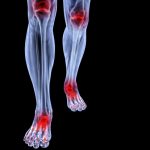 Restless leg syndrome has been found to increase the risk of stroke, heart disease and kidney disease.
Restless leg syndrome has been found to increase the risk of stroke, heart disease and kidney disease.
Restless leg syndrome (RLS) is a condition that causes a person to feel an overwhelming urge to move their legs when in an inclined position (laying down). Tingling, aching and itching sensations may occur as well.
Advertisement
Restless leg syndrome is classified as a neurological disorder that can impair a person’s ability to fall asleep. Studies estimate that one in 10 Americans suffer from RLS, but the good news is the condition is treatable.
On the other hand it can increase a person’s risk of stroke, heart disease and kidney disease.
Restless leg syndrome a risk factor for heart and kidney problems
 The new study was conducted on veterans and found restless leg syndrome increases the risk of heart and kidney disease and stroke. The findings, from the University of Tennessee Health Science Center and the University of California, reveal the strongest evidence between RLS and stroke, heart disease and kidney disease.
The new study was conducted on veterans and found restless leg syndrome increases the risk of heart and kidney disease and stroke. The findings, from the University of Tennessee Health Science Center and the University of California, reveal the strongest evidence between RLS and stroke, heart disease and kidney disease.
3,700 veterans with RLS were selected along with 3,700 without the condition and matched them based on demographic and clinical factors. Both groups were tracked for eight years and outcomes were then compared. Researchers look specifically for new cases of stroke, heart disease and kidney disease.
Those in the RLS group were four times more likely to develop stroke and heart disease and three times more likely to develop kidney disease – but this is mere association, not cause and effect. Researchers suggest that RLS may result from underlying medical conditions rather than be a cause for them. Genetics, too, may also play a role as the condition can run in families.
Some theories, which circulate the findings, involve suggesting that lack of sleep due to RLS can contribute to poorer health outcomes. Poor sleep has been associated with illness time and time again.
The researchers suggest further research needs to be conducted to determine if better treatment of RLS could reduce the future risk of stroke, heart disease and kidney disease.
Causes of restless leg syndrome (RLS)
Restless leg syndrome is a neurological disorder that genetics also plays a role in. RLS is found to run in families, and researchers have uncovered specific genes associated with RLS. Other research has shown low levels of iron in the brain in those with RLS and RLS is related to dysfunction in the brain’s basal ganglia circuits, which transfer dopamine. This is necessary to produce smooth movements. Damage to this area is also seen in Parkinson’s patients.
Other causes of RLS include kidney disease, diabetes, peripheral neuropathy, certain medications, pregnancy, alcohol and sleep deprivation.
Common signs and symptoms of restless leg syndrome (RLS)
Restless leg syndrome produces tingling, itching and uncomfortable sensations in the legs. When at rest a person with RLS will have uncontrollable urges to move their legs in order to stop the sensations. Moving legs does relieve the symptoms, but it’s impossible to continue to move your legs all day.
Advertisement
Restlessness of the legs typically gets worse at night and starts when a person is in a lying position – most likely in bed. Long periods of leg inactivity, too, can start the discomfort, i.e. long car rides.
Lifestyle changes for restless leg syndrome (RLS)
Although severe RLS requires medical treatment, mild RLS can often be treated with simple lifestyle changes. Lifestyle changes for RLS include:
 Sticking to a regular sleep schedule – fatigue can worsen symptoms associated with RLS
Sticking to a regular sleep schedule – fatigue can worsen symptoms associated with RLS- Exercising daily
- Minimizing caffeine use – caffeine can worsen symptoms of RLS
- Avoiding alcohol and cigarettes
- Speaking with a nutritionist about dietary supplements
- Losing weight
- Practicing relaxation techniques
- Trying baths and massages
- Applying cold and hot compresses
Treatment and home remedies for restless leg syndrome (RLS)
As mentioned, RLS is treatable; therefore, here are some treatment options and home remedies to help relieve RLS.
- Try wearing compression socks as pressure may relieve the discomfort.
- Try sleeping with a pillow between your legs.
- Find a work setting where you can be active and not sit or be inactive for long periods of time.
- Schedule activities that involve long periods of sitting, such as airplane rides or road trips, in the morning when symptoms aren’t as bad.
- Always choose the aisle seats on planes or movie theatres to stretch your legs.
- Stretch prior to long hours of sitting – calves, thighs ad hips.
- Medication therapy, such as medications to increase dopamine, medications that affect calcium channels, opioids and muscle relaxants. Be sure to speak with your doctor prior to beginning any medications.
